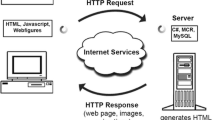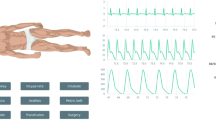Abstract
A new web-based education-oriented magnetic resonance (MR) simulator is presented. We have identified the main requirements that this simulator should comply with, so that trainees can face useful practical tasks such as setting the exact slice position and its properties, selecting the correct protocol or fitting the parameters to acquire an image. The tool follows the client-server model. The client contains the interface that mimics the console of a real machine and several of its features. The server stores anatomical models and executes the bulk of the simulation. This cross-platform simulator has been used in two real educational scenarios. The acceptance of the tool has been measured using two criteria, namely, the System Usability Scale and the Likelihood to Recommend, both with satisfactory results. Therefore, we conclude that given the potential of the tool, it may play a relevant role for the training of MRI operators and other involved personnel.







Similar content being viewed by others
References
Edelman, R.R., The history of mr imaging as seen through the pages of radiology. Radiology 273(2S):S181–S200, 2014.
Muhammed, E., and Azim, Ç., MRI Handbook. New York: Springer, 2012. Yeni Yüzyl University, Cevizlibaġ Topkapi, Turkey 1 edition.
Noz, M.E., Erdman, W.A., Maguire, G.Q., Stahl, T.J., Tokarz, R.J., Menken, K.L., and Salviani, J.A., Modus operandi for a picture archiving and communication system. Radiology 152(1):221–223, 1984.
Huang, H.K., Three methods of implementing a picture archiving and communication system. RadioGraphics 12(1):131–139 , 1992.
Hagmann, P., Jonasson, L., Maeder, P., Thiran, J.P., Wedeen, V.J., and Meuli, R., Understanding diffusion mr imaging techniques: from scalar diffusion-weighted imaging to diffusion tensor imaging and beyond. RadioGraphics 26(suppl_1):S205–S223, 2006.
Torheim, G., Rinck, P.A., Jones, R.A., and Kvaerness, J., A simulator for teaching mr image contrast behavior. Magn. Resonance Mater. Phys. Biology Med. 2(4):515–522, 1994.
Hackländer, T., and Mertens, H., Virtual mri: a pc-based simulation of a clinical mr scanner. Acad. Radio. 12:85–96, 2005.
Jochimsen, T.H., and von Mengershausen, M., Odin - object-oriented development interface for nmr. J Magn. Resonance 170(10):67–78, 2004.
Stöcker, T., Vahedipour, K., Pflugfelder, D., and Shah, N.J., High-performance computing mri simulations. Magn. Resonance Med. 64(1):186–193, 2010.
Zhipeng, C., Sukhoon, O., Christopher, S.T., McGarrity, J.M., Timothy, H., Wei, L., and Collins, C.M., Bloch-based mri system simulator considering realistic electromagnetic fields for calculation of signal, noise, and specific absorption rate. Magn. Resonance Med. 72(1):237–247, 2013.
Aja-Fernández, S., Vegas-Sánchez-Ferrero, G., and Tristán-Vega, A., Noise estimation in parallel mri: grappa and sense. Magn. Resonance Imag. 32(3):281–290, 2014.
Drobnjak, I., Gavaghan, D., Süli, E., Pitt-Francis, J., and Jenkinson, M., Development of a functional magnetic resonance imaging simulator for modeling realistic rigid-body motion artifacts. Magn. Resonance Med. 56 (08):364–80, 2006.
Xanthis, C.G., Venetis, I.E., and Aletras, A.H., High performance mri simulations of motion on multi-gpu systems. Cardiovascular Magn. Resonance 16(1):48, 2014.
Andria, G., Attivissimo, F., Cavone, G., and Lanzolla, A.M.L., Acquisition times in magnetic resonance imaging: optimization in clinical use. IEEE Trans. Instr. Meas. 58(9):3140–3148, 2009.
Hansen, M. S., and Sørensen, T. S., Gadgetron: an open source framework for medical image reconstruction. Magn. Resonance Med. 69(6):1768–1776, 2012.
Zwart, N.R., and Pipe, J.G., Graphical programming interface: a development environment for mri methods. Magn. Resonance Med. 74(5):1449–1460, 2014.
Uecker, M., Ong, F., Tamir, J.I., Bahri, D., Virtue, P., Cheng, J.Y., Zhang, T., and Lustig, M.: Berkeley advanced reconstruction toolbox. In: Proceedings of the International Society for Magnetic Resonance Medicine. Annual Meeting of the International Society for Magnetic Resonance in Medicine, p. 2486, 2015.
Drobnjak, I., Pell, G.S., and Jenkinson, M., Simulating the effects of time-varying magnetic fields with a realistic simulated scanner. Magn. Reson. Imag. 28(7):1014–1021, 2010.
Graham, M.S., Drobnjak, I., and Zhang, H., Realistic simulation of artefacts in diffusion mri for validating post-processing correction techniques. NeuroImage 125:1079–1094, 2016.
Graham, M.S., Drobnjak, I., Jenkinson, M., and Zhang, H., Quantitative assessment of the susceptibility artefact and its interaction with motion in diffusion mri. PLOS ONE 12(10):1–25, 2017.
Benoit-Cattin, H., Collewet, G., Belaroussi, B., Saint-Jalmes, H., and Odet, C., The simri project: a versatile and interactive mri simulator. J Magn. Reson. 173(1):97–115, 2005.
Xanthis, C.G., Venetis, I.E., Chalkias, A.V., and Aletras, A.H., Mrisimul: a gpu-based parallel approach to mri simulations. IEEE Trans Med Imag 33:607–617, 2014.
Kose, R., and Kose, K., Blochsolver: a gpu-optimized fast 3d mri simulator for experimentally compatible pulse sequences. J Magn. Reson. 281:51–65, 2017.
Liu, F., Velikina, J.V., Block, W.F., Kijowski, R., and Samsonov, A.A., Fast realistic mri simulations based on generalized multi-pool exchange tissue model. IEEE Trans. Med. Imag. 36(2):527–537, 2017.
Anderson, C., The Model-View-View Model (MVVM) Design Pattern, pp. 461–499. Berkeley: A press, 2012.
Burch, C., Django: a web framework using python: tutorial presentation. J Comput. Sci. Colleges 25(5): 154–155, 2010.
Hähn, D., Rannou, N., Ahtam, B., Grant, P.E., and Pienaar, R.: Neuroimaging in the browser using the x toolkit. In: Proceedings of the 5th INCF Congress of Neuroinformatics, Munich, Germany, 2012.
Ramos-Llordén, G., den Dekker, A.J., Van Steenkiste, G., Jeurissen, B., Vanhevel, F., Van Audekerke, J., Verhoye, M., and Sijbers, J., A unified maximum likelihood framework for simulatneous motion and t1 estimation in quantitaive MR t1 mapping. IEEE Trans. Med. Imag. 36(2):433–466, 2017.
Lauterbur, P.C., and Liang, Z.-P.: Principles of magnetic resonance imaging: a signal processing perspective. IEEE Press Series on Biomedical Engineering, 2000
Handbook of MRI Pulse Sequences. In: Bernstein, M.A., King, K.F., and Zhou, X.J. (Eds.) Academic Press, Burlington, 2004.
Brooke, J., Sus: a quick and dirty usability scale. Usability Eval. Ind. 189:11, 1995.
Lewis, J.R., and Sauro, J.: The factor structure of the system usability scale. In: Kurosu, M. (Ed.) Human Centered Design, pp. 94–103. Springer, Berlin, 2009.
Lewis, J.R., Usability: lessons learned and yet to be learned. Int. J Human–Comput. Int. 30(9):663–684, 2014.
Tullis, T.S., and Stetson, J.N.: A comparison of questionnaires for assessing website usability. In: Usability Professionals Association (UPA) 2004 Conference, 2004.
Bangor, A., Kortum, P., and Miller, J., Determining what individual sus scores mean: adding an adjective rating scale. J. Usability Studies 4(3):114–123, 2009.
Acknowledgments
This work has been funded in part by the Junta de Castilla y León, Spain, and by the company Giveme5D, Valladolid, Spain. The authors would like to thank the SERAM, the Hospital San Carlos as well as Fátima Matute, MD, and Prof. José Ramón Casar Corredera, PhD, for their invaluable help to carry out the educational experiments. We also acknowledge grant TEC2017-82408-R.
Author information
Authors and Affiliations
Corresponding author
Ethics declarations
This work has been carried out at the University of Valladolid and has been partially funded by the company Giveme5D, Valladolid, Spain. A technology transfer agreement has been signed by both parties. The second author is the main shareholder of this company; he has provided radiological guidance throughout the simulator design process.
All information related to the tests described in the paper was obtained anonymously and with the participants consent to use this information for research purposes.
Additional information
Publisher’s Note
Springer Nature remains neutral with regard to jurisdictional claims in published maps and institutional affiliations.
This article is part of the Topical Collection on Education & Training
Electronic supplementary material
Below is the link to the electronic supplementary material.
Rights and permissions
About this article
Cite this article
Treceño-Fernández, D., Calabia-del-Campo, J., Bote-Lorenzo, M.L. et al. A Web-Based Educational Magnetic Resonance Simulator: Design, Implementation and Testing. J Med Syst 44, 9 (2020). https://doi.org/10.1007/s10916-019-1470-7
Received:
Accepted:
Published:
DOI: https://doi.org/10.1007/s10916-019-1470-7




